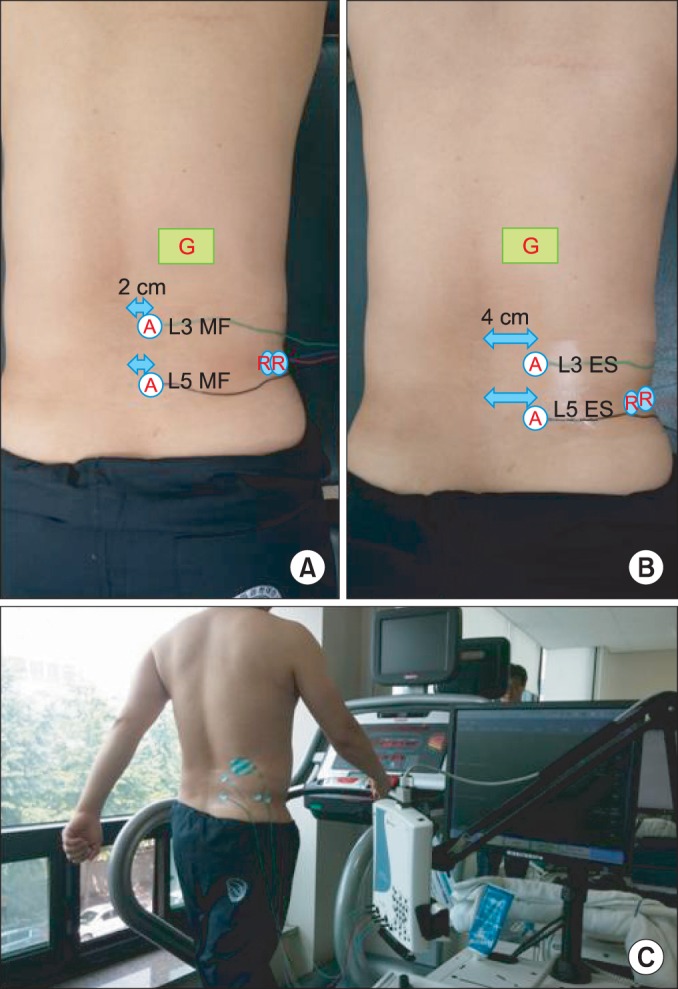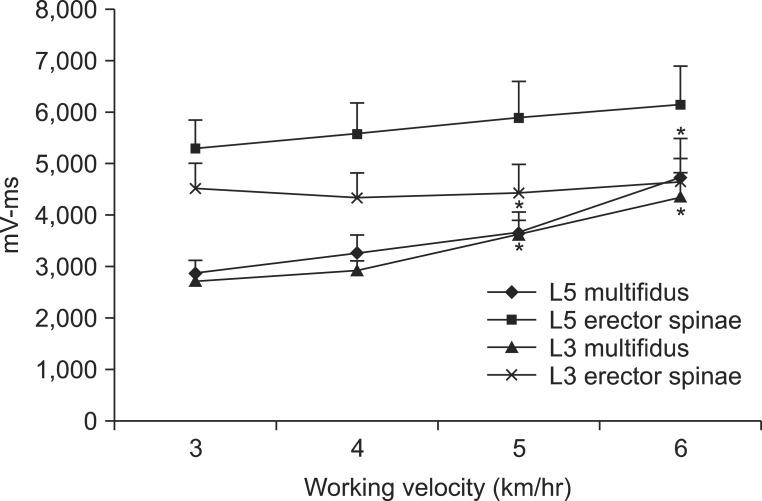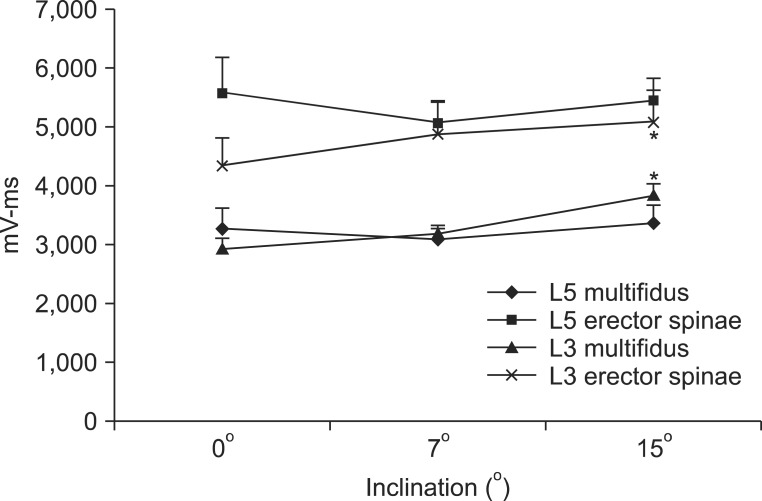Ann Rehabil Med.
2014 Aug;38(4):514-522. 10.5535/arm.2014.38.4.514.
Facilitating Effects of Fast and Slope Walking on Paraspinal Muscles
- Affiliations
-
- 1Department of Rehabilitation Medicine, CHA Bundang Medical Center, CHA University, Seongnam, Korea.
- 2Department of Rehabilitation Medicine, Seoul National University Bundang Hospital, Seoul National University College of Medicine, Seongnam, Korea. jseok337@hanmail.net
- KMID: 2165734
- DOI: http://doi.org/10.5535/arm.2014.38.4.514
Abstract
OBJECTIVE
To quantify the activation of the paraspinalis muscles (multifidus and erector spinae) at different walking velocities and slope with surface electromyography.
METHODS
This study was a prospective experimental study involving ten healthy male participants. Surface electrodes were placed over the multifidus and erector spinae muscles at the L5 and L3 level. After the electrode was placed at the lumbar paraspinalis muscles, electromyography signals were recorded over 20 seconds. Data were collected three times during the walking exercise at a 0degrees gradient with the speed from 3 to 6 km/hr. At 7degrees gradient and 15degrees gradient, data were also collected three times but a walking speed of 4 km/hr. The area under the curve was calculated for quantitative measurement of muscle activation.
RESULTS
While the muscle activation was increased at higher walking velocities at the L5 and L3 levels of the multifidus, the erector spinae muscle activation did not show any change at higher walking velocities. At L3 level of the multifidus and erector spine muscles, the muscle activation was significantly increased in 15degrees gradient compared to those seen in at 0degrees gradient. At L5 level, the multifidus and erector spinae muscle activation in 0degrees gradient was not significantly different from that those seen in 7degrees or 15degrees gradient.
CONCLUSION
Fast walking exercise activates lumbar multifidus muscles more than the slow walking exercise. Also, the mid lumbar muscles are comparatively more activated than low lumbar muscles when the walking slope increases.
Keyword
MeSH Terms
Figure
Cited by 1 articles
-
Changes in Activation of Serratus Anterior, Trapezius and Latissimus Dorsi With Slouched Posture
Seok Tae Lee, Jinkyoo Moon, Seung Hoon Lee, Kye Hee Cho, Sang Hee Im, MinYoung Kim, Kyunghoon Min
Ann Rehabil Med. 2016;40(2):318-325. doi: 10.5535/arm.2016.40.2.318.
Reference
-
1. Waddell G. 1987 Volvo award in clinical sciences: a new clinical model for the treatment of low-back pain. Spine (Phila Pa 1976). 1987; 12:632–644. PMID: 2961080.
Article2. Andersson GB. Epidemiological features of chronic low-back pain. Lancet. 1999; 354:581–585. PMID: 10470716.
Article3. Hides JA, Jull GA, Richardson CA. Long-term effects of specific stabilizing exercises for first-episode low back pain. Spine (Phila Pa 1976). 2001; 26:E243–E248. PMID: 11389408.
Article4. Lee HI, Song J, Lee HS, Kang JY, Kim M, Ryu JS. Association between cross-sectional areas of lumbar muscles on magnetic resonance imaging and chronicity of low back pain. Ann Rehabil Med. 2011; 35:852–859. PMID: 22506214.
Article5. Hides JA, Richardson CA, Jull GA. Magnetic resonance imaging and ultrasonography of the lumbar multifidus muscle: comparison of two different modalities. Spine (Phila Pa 1976). 1995; 20:54–58. PMID: 7709280.6. Hides JA, Stokes MJ, Saide M, Jull GA, Cooper DH. Evidence of lumbar multifidus muscle wasting ipsilateral to symptoms in patients with acute/subacute low back pain. Spine (Phila Pa 1976). 1994; 19:165–172. PMID: 8153825.
Article7. Stokes MJ, Cooper RG, Morris G, Jayson MI. Selective changes in multifidus dimensions in patients with chronic low back pain. Eur Spine J. 1992; 1:38–42. PMID: 20054946.
Article8. Comerford MJ, Mottram SL. Movement and stability dysfunction: contemporary developments. Man Ther. 2001; 6:15–26. PMID: 11243905.9. Hides JA, Richardson CA, Jull GA. Multifidus muscle recovery is not automatic after resolution of acute, first-episode low back pain. Spine (Phila Pa 1976). 1996; 21:2763–2769. PMID: 8979323.
Article10. Foster NE, Thompson KA, Baxter GD, Allen JM. Management of nonspecific low back pain by physiotherapists in Britain and Ireland: a descriptive questionnaire of current clinical practice. Spine (Phila Pa 1976). 1999; 24:1332–1342. PMID: 10404576.11. Stevens VK, Vleeming A, Bouche KG, Mahieu NN, Vanderstraeten GG, Danneels LA. Electromyographic activity of trunk and hip muscles during stabilization exercises in four-point kneeling in healthy volunteers. Eur Spine J. 2007; 16:711–718. PMID: 16896840.
Article12. Ekstrom RA, Osborn RW, Hauer PL. Surface electromyographic analysis of the low back muscles during rehabilitation exercises. J Orthop Sports Phys Ther. 2008; 38:736–745. PMID: 19195137.
Article13. Callaghan JP, Patla AE, McGill SM. Low back three-dimensional joint forces, kinematics, and kinetics during walking. Clin Biomech (Bristol, Avon). 1999; 14:203–216.
Article14. Anders C, Wagner H, Puta C, Grassme R, Petrovitch A, Scholle HC. Trunk muscle activation patterns during walking at different speeds. J Electromyogr Kinesiol. 2007; 17:245–252. PMID: 16517182.
Article15. Saunders SW, Schache A, Rath D, Hodges PW. Changes in three dimensional lumbo-pelvic kinematics and trunk muscle activity with speed and mode of locomotion. Clin Biomech (Bristol, Avon). 2005; 20:784–793.
Article16. Lamoth CJ, Daffertshofer A, Meijer OG, Beek PJ. How do persons with chronic low back pain speed up and slow down? Trunk-pelvis coordination and lumbar erector spinae activity during gait. Gait Posture. 2006; 23:230–239. PMID: 16399520.17. Lamoth CJ, Meijer OG, Daffertshofer A, Wuisman PI, Beek PJ. Effects of chronic low back pain on trunk coordination and back muscle activity during walking: changes in motor control. Eur Spine J. 2006; 15:23–40. PMID: 15864670.
Article18. Danneels LA, Coorevits PL, Cools AM, Vanderstraeten GG, Cambier DC, Witvrouw EE, et al. Differences in electromyographic activity in the multifidus muscle and the iliocostalis lumborum between healthy subjects and patients with sub-acute and chronic low back pain. Eur Spine J. 2002; 11:13–19. PMID: 11931058.
Article19. Arokoski JP, Valta T, Airaksinen O, Kankaanpaa M. Back and abdominal muscle function during stabilization exercises. Arch Phys Med Rehabil. 2001; 82:1089–1098. PMID: 11494189.
Article20. Boudreau S, Farina D, Kongstad L, Buus D, Redder J, Sverrisdottir E, et al. The relative timing of trunk muscle activation is retained in response to unanticipated postural-perturbations during acute low back pain. Exp Brain Res. 2011; 210:259–267. PMID: 21442223.
Article21. Barker KL, Shamley DR, Jackson D. Changes in the cross-sectional area of multifidus and psoas in patients with unilateral back pain: the relationship to pain and disability. Spine (Phila Pa 1976). 2004; 29:E515–E519. PMID: 15543053.22. Hides J, Gilmore C, Stanton W, Bohlscheid E. Multifidus size and symmetry among chronic LBP and healthy asymptomatic subjects. Man Ther. 2008; 13:43–49. PMID: 17070721.
Article23. Kjaer P, Bendix T, Sorensen JS, Korsholm L, Leboeuf-Yde C. Are MRI-defined fat infiltrations in the multifidus muscles associated with low back pain? BMC Med. 2007; 5:2. PMID: 17254322.
Article24. Wallwork TL, Stanton WR, Freke M, Hides JA. The effect of chronic low back pain on size and contraction of the lumbar multifidus muscle. Man Ther. 2009; 14:496–500. PMID: 19027343.
Article25. Ward SR, Kim CW, Eng CM, Gottschalk LJ 4th, Tomiya A, Garfin SR, et al. Architectural analysis and intraoperative measurements demonstrate the unique design of the multifidus muscle for lumbar spine stability. J Bone Joint Surg Am. 2009; 91:176–185. PMID: 19122093.
Article26. Danneels LA, Vanderstraeten GG, Cambier DC, Witvrouw EE, Bourgois J, Dankaerts W, et al. Effects of three different training modalities on the cross sectional area of the lumbar multifidus muscle in patients with chronic low back pain. Br J Sports Med. 2001; 35:186–191. PMID: 11375879.
Article27. Barton CJ, Coyle JA, Tinley P. The effect of heel lifts on trunk muscle activation during gait: a study of young healthy females. J Electromyogr Kinesiol. 2009; 19:598–606. PMID: 18472278.
Article28. Stokes IA, Henry SM, Single RM. Surface EMG electrodes do not accurately record from lumbar multifidus muscles. Clin Biomech (Bristol, Avon). 2003; 18:9–13.
Article
- Full Text Links
- Actions
-
Cited
- CITED
-
- Close
- Share
- Similar articles
-
- Thoracolumbar Paraspinal Myonecrosis after Aortic Dissection
- Effects of Fast Treadmill Training on Spinal Alignment and Muscles Thickness
- Factors associated with paravertebral muscle cross-sectional area in patients with chronic low back pain
- Effects of the Off-Loading Brace on the Activation of Femoral Muscles: A Preliminary Study
- Effects of Walking Exercise Intensities on Fatigue, Serum Lipids and Immune Function among Middle-Aged Women




